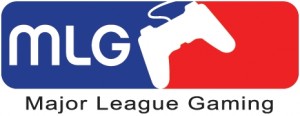Competitive Gaming: A New Frontier for Advertising?
 Most of us remember playing a video game at some point in our lives. Whether it was an occasional Mario Kart race or challenging friends to the Madden gridiron, video games have always provided some capacity of entertainment value. But who knew this $15.9 billion industry could drive a competitive segment of the market, aptly termed “E-Sports,” to the attention of some of America’s most recognizable brands? After stumbling upon this article, some additional research yielded the answer: Major League Gaming (MLG).
Most of us remember playing a video game at some point in our lives. Whether it was an occasional Mario Kart race or challenging friends to the Madden gridiron, video games have always provided some capacity of entertainment value. But who knew this $15.9 billion industry could drive a competitive segment of the market, aptly termed “E-Sports,” to the attention of some of America’s most recognizable brands? After stumbling upon this article, some additional research yielded the answer: Major League Gaming (MLG).
Believe it or not, a professional North American electronics sports organization exists, and it has begun to add another dimension to marketing, advertising and consumer engagement. Founded in 2002 by Sundance DiGiovanni and Mike Sepso, MLG has worked to permeate competitive gaming into the fabric of mainstream culture in hopes of catapulting “E-Sports” into the public eye.
Over the past several years, MLG’s rising popularity has attracted companies and brands such as Intel, LG, Red Bull, Old Spice, HP, Stride, Dr Pepper, and ESPN, all of whom are now signing title sponsorships and endorsement deals with the organization and its professional gamers in hopes of capitalizing on this market segment. With its relatively young consumer base, advertisers have begun to recognize the true potential of the gaming world.
While you may not have heard of MLG (nor had I), its video game tournaments, hosted throughout the United States, Canada and soon Europe and South America, have been broadcast on television, ESPN.com, and other broadband sites across the world. One of the most recent MLG events attracted over 15,000 spectators, 1,300 competitors, and nearly half a million people from 164 countries who tuned in to the live streams.
Competitive gaming is not a new phenomenon. But is it finally catching on?
With more and more companies willing to dish out top dollar to advertise with MLG, one would assume so. However, competitive gaming has struggled to gain significant recognition in the United States, but its popularity in other countries around the globe has multiplied. International competitive leagues, particularly in South Korea, now boast five figure prize pools, with top players often accruing similar salaries.
At its core, competitive gaming has a passionate fan base that represents a new breed of profitable opportunities. According to a 2010 estimate, nearly 67 percent of U.S. households now play some form of video games. Yet, a majority of American companies have been reluctant to back video game-based organizations such as MLG for fear of reputational backlash. Unlike other regions of the world, American societal and cultural norms still write off competitive gaming as nothing more than misplaced energy.
MLG’s success may soon rewrite that notion as the question has started to swing from “if” to “when” more American companies will step into the realm of competitive gaming. ![]()
Kevin Anthony is an intern at CJP Communications
